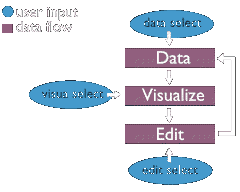-Flow
Blender had been designed with this flow diagram in mind:

A user selects data. This means that the user decides which part of the 3D world will be worked at. The Blender universe is organized in an object oriented structure.
At the top level are (Unix/Dos) files and scenes. One single file can contain several scenes, the scenes contain the 3D-objects, materials, animation curves, rendering options etc.
-Visua select
This data can then be visualized in windows. As 3D wireframe,
or Z-buffer rendered, or as buttons, as a schematic diagram, as animation
curves, as sequences, as a file system. Blender offers an extremely flexible
window system. Any non-overlapping screen lay-out is possible.
-Edit select
Based on the selected window - the visualization chosen
- the user obtains a set of editing tools. Editing is always done directly
at the data. This sounds quite obvious but this is where common 3D software
fails in being intuitive and interactive.
Mainly this is a speed problem: it can take minutes before
you see the result of an editing command.
It's also an 'inverse correction' problem: the user is
only aware of the visualization, not the actual data it represents. It
can be very confusing when you try to do something and you see the opposite!
Blender has a fast visualization system, under perfect
control of the user.
It offers a wide selection of tools, all of them at choice
accessible with a single mouse click, as a keyboard command, popup menu's
or even mouse gestures!
 introduction
introduction